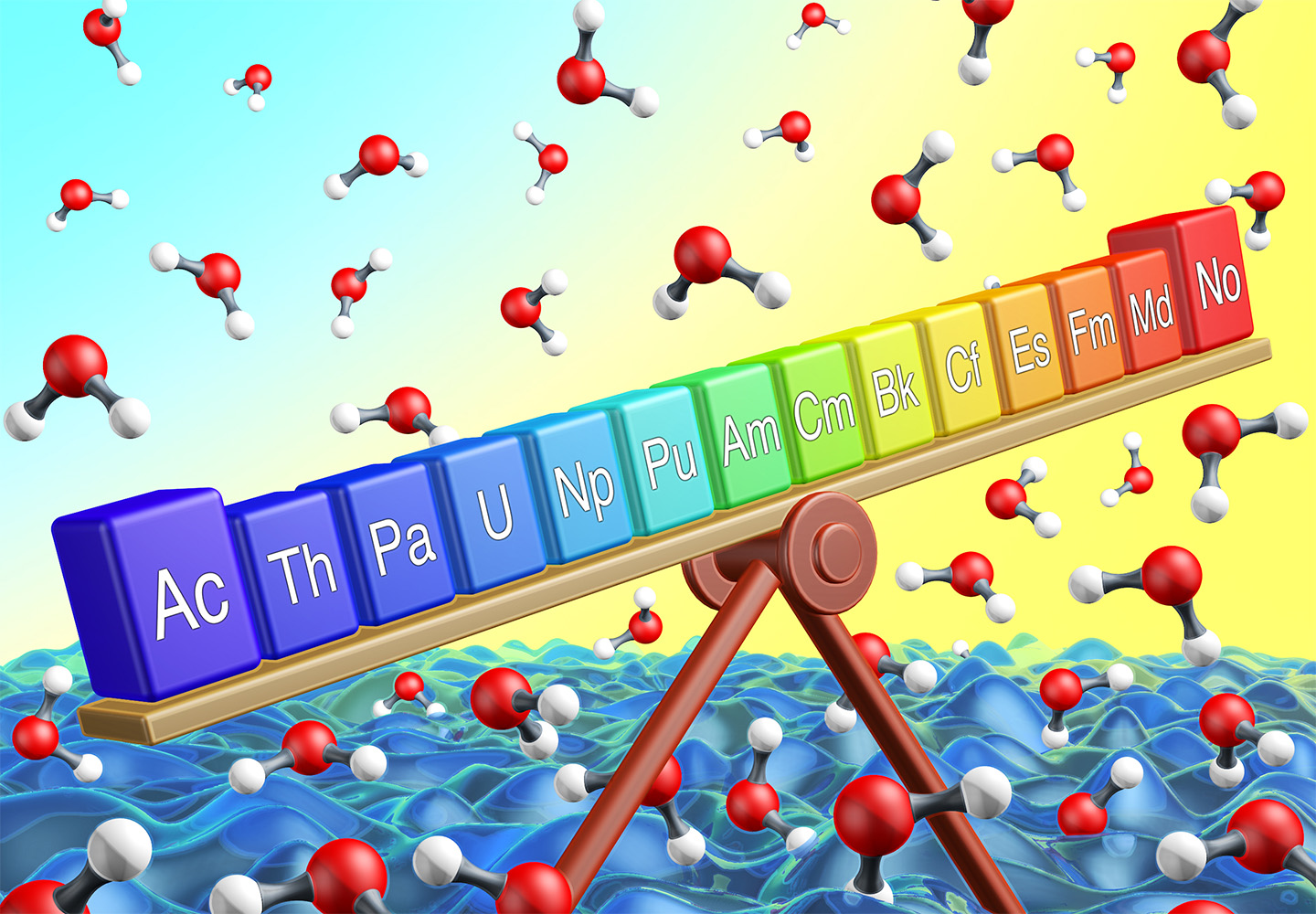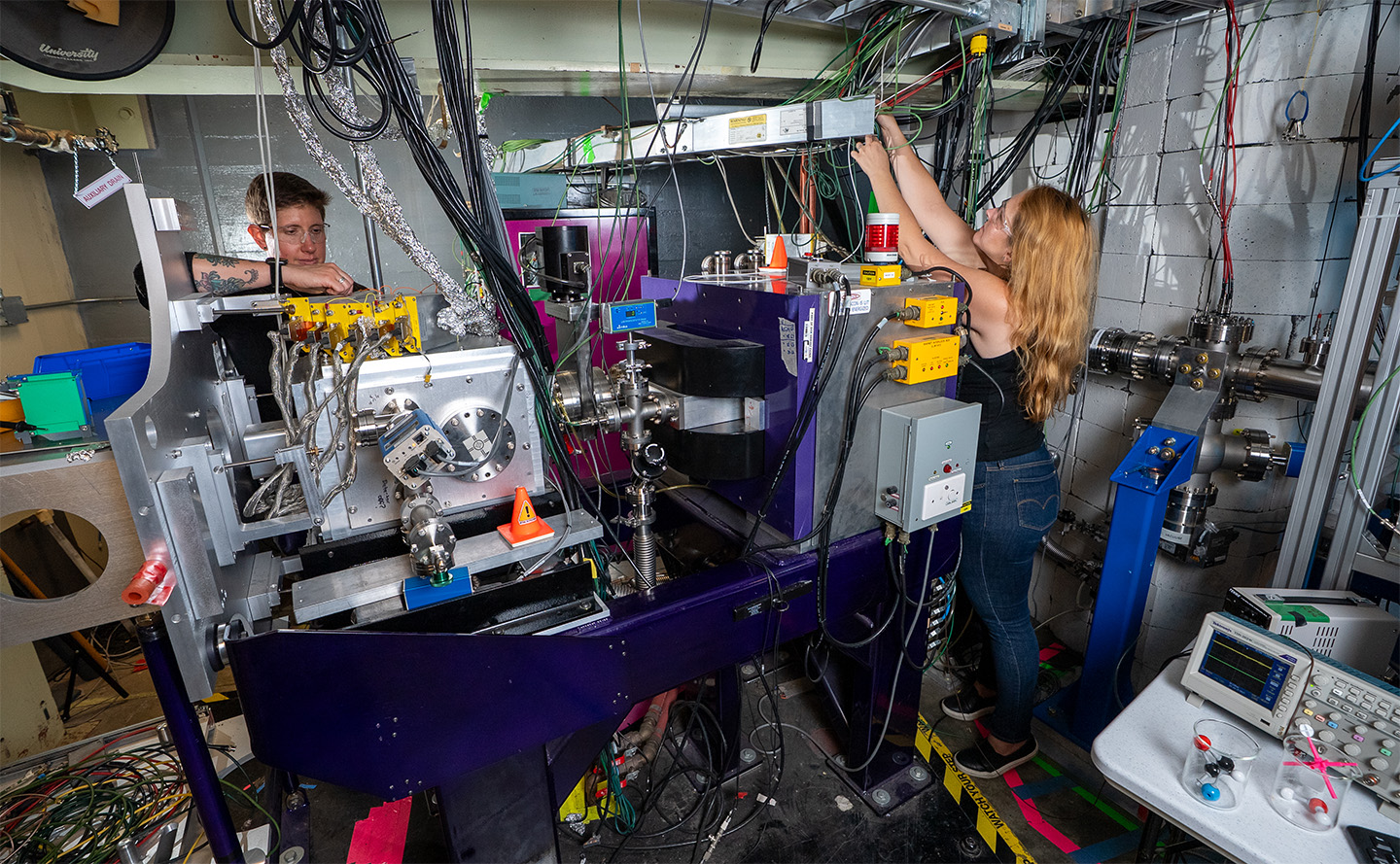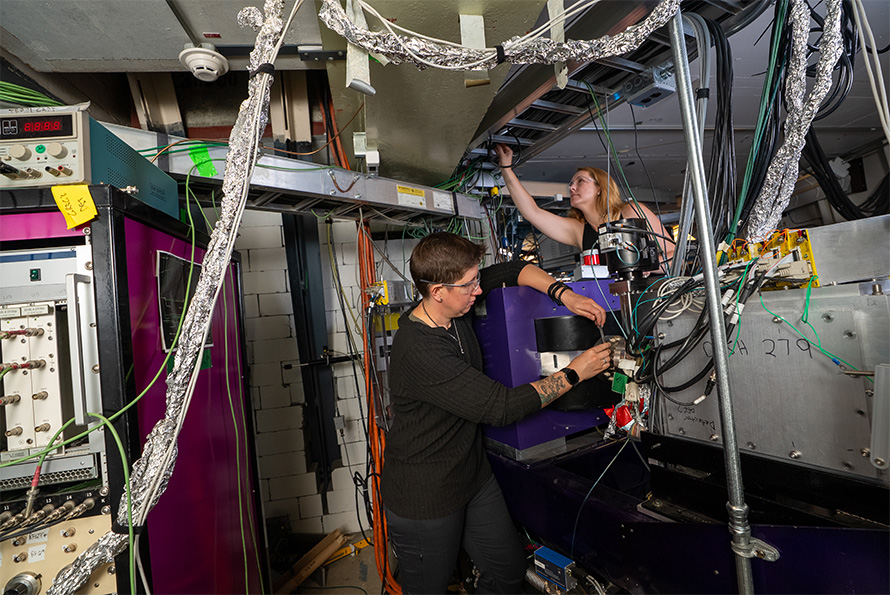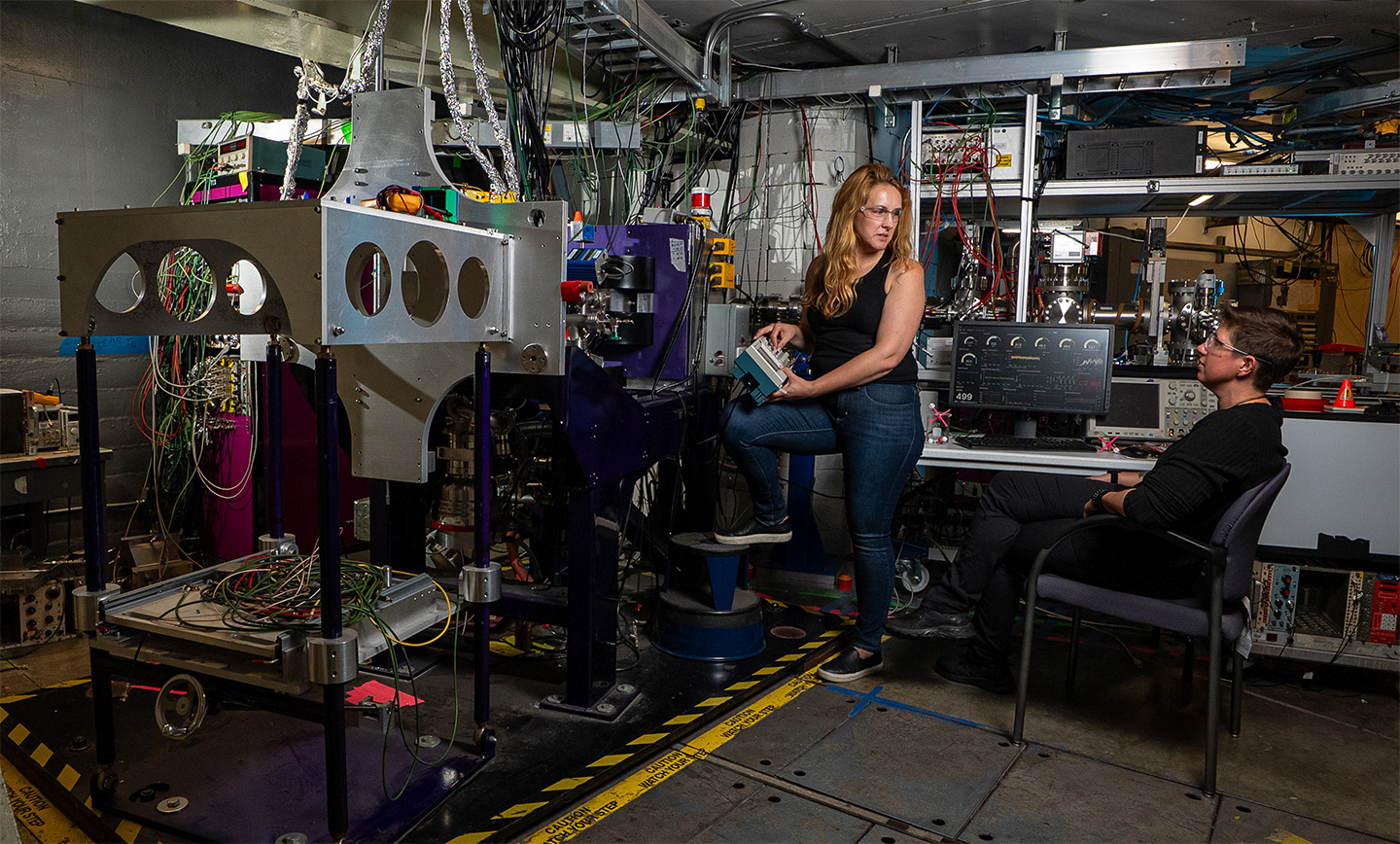Key Takeaways
- Scientists at Berkeley Lab's 88-Inch Cyclotron developed a new technique for atom-at-a-time chemistry that opens up the next generation of heavy- and superheavy-element studies.
- This is the first time researchers have made a direct measurement of a molecule containing an element with more than 99 protons (nobelium, element 102).
- It's also the first direct comparison of chemistry between molecules made with extremes of the actinide elements (actinium and nobelium).
- Understanding elements' chemistries helps researchers better predict their behavior and design ways to produce or use specific molecules. That knowledge could improve the radioisotopes used in medicine.
The periodic table is one of the triumphs of science. Even before certain elements had been discovered, this chart could successfully predict their masses, densities, how they would link up with other elements, and a host of other properties.
But at the bottom of the periodic table, where massive atoms are practically bursting at the seams with protons, its predictive power might start to break down. Experiments to study the chemistry of the heaviest elements - especially the superheavy elements, which have more than 103 protons - have long been a challenge. Despite using specialized facilities, researchers have been unable to definitively identify the molecular species they produce in experiments. This uncertainty has hindered progress in the field, since scientists have had to rely on educated guesses rather than precise knowledge of the chemistry being observed.
Now, researchers have used the 88-Inch Cyclotron at the Department of Energy's Lawrence Berkeley National Laboratory (Berkeley Lab) to develop a new technique to make and directly detect molecules containing heavy and superheavy elements. In a study published today in the journal Nature, a team of researchers from Berkeley Lab, UC Berkeley, and The University of Alabama used the method to create molecules containing nobelium, element 102. It is the first time scientists have directly measured a molecule containing an element greater than 99.
"What is really exciting is that this opens the door to the next generation of atom-at-a-time chemistry studies - so looking at the chemistry of superheavy elements and asking whether or not they are in the correct positions on the periodic table," said Jennifer Pore, scientist at Berkeley Lab and lead author of the paper. "I think we're going to completely change how superheavy-element chemistry is done."
The team's setup also produced molecules containing actinium, element 89. This let them simultaneously study the extremes of the actinide series, the group on the periodic table that spans elements 89 to 103. Researchers recorded how frequently actinium and nobelium bonded with one or more water or nitrogen molecules, providing new information about how the actinides interact within the same experiment.
"This was the first time anyone's ever done a direct comparison of an early actinide to a late actinide element," Pore said. "We weren't surprised by any of the chemistry results - they fit with what makes sense for the trend. But the fact that we could see the chemistry of these things we're producing one atom at a time, and directly observe the molecular species, was really exciting."
What was a surprise to the researchers was how effortlessly they made the nobelium molecules in the first place.

Unexpected molecules
The original plan for the experiment went like this: The 88-Inch Cyclotron would accelerate a beam of calcium isotopes into a target of thulium and lead, producing a spray of particles that included the actinides of interest. The Berkeley Gas Separator would clear out the extra particles, sending only the actinium and nobelium to a cone-shaped gas catcher. Exiting that funnel at supersonic speeds, the gas would expand, interacting with another jet of reactive gas to create molecules. Electrodes would then speed those molecules into FIONA, a state-of-the-art spectrometer that could measure their masses and determine exactly what molecules had formed.
But before the researchers had a chance to inject their reactive gas, they noticed something unexpected: They were already recording molecules containing nobelium in their detector. Stray nitrogen and water, present in only minuscule amounts within FIONA, had combined with the nobelium atoms.
"We assumed that we would not be making molecules in the experiment before we wanted to," said Jacklyn Gates, a nuclear scientist at Berkeley Lab and co-author of the paper. "The fact that we do is an important point, because no other atom-at-a-time chemistry setups have molecule identification availability, and they have always assumed that they don't make molecules."

Researchers previously thought that the stringent processes to clean the gas in their systems would leave an insignificant amount of water and nitrogen molecules behind, and that there wouldn't be enough energy in their reactions to break those bonds and reform molecules unintentionally. But that wasn't the case.
"For the types of molecules we're making here, you don't have to break bonds. The metal ions find the water and they stick together to form these molecular species," Pore said. "There are potential implications for superheavy-element studies, because we made a lot of molecules even with our clean setup. With this result, researchers will have to think more carefully about what they're actually making in their systems."
Unexpected molecule formation could help explain previous conflicting experiments that studied whether flerovium, element 114, behaves like a noble gas (elements that tend not to interact with other materials because of the way their electrons are arranged). This discovery may also shed new light on the interpretation of recent studies on element 113 and 115, and inform all future gas-phase studies of superheavy elements.

Fabulous FIONA
After the unexpected discovery of nobelium molecules, the research team temporarily diverted from their original experiment. They ran their setup non-stop for 10 days, collecting nearly 2,000 molecules made of actinium or nobelium. That's a large amount by heavy element chemistry standards, but still an incredibly small number. For comparison, a drop of water contains more than a sextillion (that's 1 followed by 21 zeros) molecules.
"This is very different than the traditional chemistry most people think of, where you have beakers with lots and lots of liquid," Pore said. "We're working with extremely small amounts of material, far beyond what the human eye can detect. The ability to extract meaningful information from these tiny samples is a big deal. FIONA is much faster than anything that's ever been done before, and more sensitive. This is important because everything we study is radioactive and only exists for a few seconds or less before it disappears."
Sensitivity and speed are essential as researchers move to study the chemistry of heavier and heavier elements, which grow increasingly difficult to make and quicker to decay as they become more massive. While previous techniques were limited to molecules that lived for about 1 second, the team's experimental setup can study ones that only survive for 0.1 seconds, and the experimenters have control of how long the particles are trapped at every stage of the process.


Previous experiments measured the secondary particles made when a molecule with a superheavy element decayed - but they couldn't identify the exact original chemical species. Most measurements reported a range of possible molecules and were based on assumptions from better-known elements. The new approach is the first to directly identify the molecules by measuring their masses, removing the need for such assumptions.
"FIONA is really the secret sauce for the chemistry, and FIONA wasn't even designed to do chemistry," Gates said. "It was designed just to do mass measurements, so this is like a fun side hustle. We can do these chemistry studies with very little modification to the system, and we have this unique capability of identifying molecular species. There's going to be a lot of new, exciting results coming out using this technique."
Researchers plan to use their approach with several early superheavy elements, pairing the atoms with fluorine-containing gases and short-chain hydrocarbons to reveal fundamental chemistry at the bottom of the periodic table.
Better models, better medicine
A better understanding of heavy and superheavy elements has several benefits. Experiments can check the chemistries of the elements, making sure they are grouped correctly on the periodic table and improving its predictive power. At the same time, researchers are also assessing models of the atom and the fundamental forces at play.
Odd chemical behavior in the heavier elements arises in part from "relativistic effects." The large number of protons in the nucleus creates an intense charge that pulls on the inner electrons, speeding them up. As some of the electrons are sucked towards the center of the atom, they shield some of the outer electrons from the pull. These effects can cause an element's chemistry to behave in unexpected ways. (The color of gold, different from the gray of so many other metals, is one such example.)

"The electrons behave very differently in elements where you have these large relativistic effects, and the effect is expected to be even stronger in the superheavy elements," Pore said. "This is why they might potentially not be in the right place on the periodic table."
There are also practical applications, particularly in improving radioactive isotopes used in medical treatment. One of great interest is an isotope of actinium (actinium-225), which has shown promising results in treating certain metastatic cancers. However, the isotope is difficult to make and only available in small quantities every year, limiting access for clinical trials and treatment. Scientists are just beginning to understand its chemistry.
"People have been forced to skip the fundamental chemistry step to figure out how to get it into patients," said Pore. "But if we could understand the chemistry of these radioactive elements better, we might have an easier time producing the specific molecules needed for cancer treatment."
This work included collaboration between Berkeley Lab's Nuclear Science Division and Chemical Sciences Division, and was funded in part by DOE's Nuclear Physics, Basic Energy Sciences, and Laboratory Directed Research and Development (LDRD) programs.






